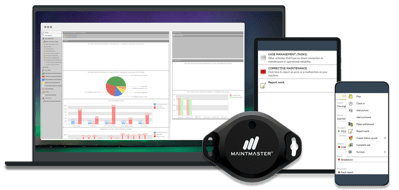Table of Contents
- What is a preventive maintenance plan?
- Step 1: Define your maintenance goals
- Step 2: Identify critical equipment
- Step 3: Define maintenance tasks and intervals
- Step 4: Assign responsibilities and resources
- Step 5: Create a preventive maintenance schedule
- Step 6: Track and monitor maintenance activities
- Step 7: Continuously improve the preventive maintenance plan
- Step 8: Work data-driven and use your maintenance system to keep track
- Final thoughts
Preventive maintenance (PM) is one of the most effective ways to ensure equipment reliability, reduce downtime, and lower long-term maintenance costs. Yet, many organisations struggle to implement a structured preventive maintenance plan, often falling into a reactive approach—fixing equipment only when it breaks down. This leads to unexpected production stops, high repair costs, and unnecessary stress for maintenance teams.
A well-defined preventive maintenance plan provides a structured way to manage maintenance activities, ensuring that equipment is serviced before failures occur. This guide will outline the key steps to creating and implementing a preventive maintenance plan, helping maintenance professionals and managers take a proactive approach to asset management.
What is a preventive maintenance plan?
A preventive maintenance plan is a structured schedule of maintenance activities designed to prevent unexpected failures. It includes regular inspections, servicing, and parts replacements at scheduled intervals, rather than waiting for equipment to break down. The goal is to improve equipment reliability, reduce unplanned downtime, and extend asset lifespan.
Unlike reactive maintenance, which deals with breakdowns as they occur, preventive maintenance follows a planned schedule. This approach helps reduce repair costs and ensures that maintenance work is performed under controlled conditions, rather than in emergency situations that disrupt operations.

Step 1: Define your maintenance goals
Before developing a preventive maintenance plan, it is important to define clear objectives. Maintenance teams should determine what they aim to achieve with a structured maintenance schedule. The most common goals include reducing unplanned downtime, extending the lifespan of critical assets, improving workplace safety, and ensuring compliance with regulatory requirements. Cost reduction is another key factor, as preventive maintenance helps minimise expensive emergency repairs and unexpected failures.
To define maintenance goals:
- Identify the most common breakdowns and their causes.
- Determine how preventive maintenance can address these issues.
- Set measurable targets, such as reducing downtime by a certain percentage.
- Align maintenance objectives with overall business goals.
By identifying these goals early, organisations can align their maintenance strategy with their operational needs. A well-structured plan provides measurable benefits, making it easier to track progress and adjust strategies as necessary.
Step 2: Identify critical equipment
Not all assets require the same level of maintenance, and it is important to prioritise equipment based on its role in production and overall operational impact. Critical assets—those that would cause significant disruptions if they fail—should be the focus of a preventive maintenance plan.
Wilkinson Sword, a global manufacturer of high-precision razors, has taken a strategic approach to modernising their maintenance operations. By partnering with MaintMaster, they initiated a digital transformation of their maintenance processes to better monitor, analyse, and improve asset reliability. With the new system in place, they can prioritise maintenance based on asset performance data, track recurring issues, and ensure that critical equipment receives timely preventive care.
To prioritise critical equipment:
- Identify assets that have the highest impact on production.
- Analyse past maintenance records to find frequent failure points.
- Consider manufacturer recommendations for servicing.
- Group assets into high, medium, and low priority based on failure impact.
When prioritising assets, organisations should consider factors such as the cost of failure, the frequency of breakdowns, and manufacturer recommendations. This approach helps ensure that maintenance resources are allocated effectively.
Step 3: Define maintenance tasks and intervals
Once critical assets are identified, the next step is defining the specific maintenance tasks required for each piece of equipment. Different types of preventive maintenance strategies can be applied, depending on the nature of the asset and its operational requirements.
To define maintenance tasks and schedules:
- Use predetermined maintenance for tasks that need regular servicing (e.g., every 3 months).
- Implement predictive maintenance is when real-time monitoring can indicate potential failures.
- Apply condition-based maintenance for assets that require servicing after a specific number of operating hours.
- Document each task, specifying tools, spare parts, and procedures.
MaintMaster CMMS helps organisations implement these strategies by allowing maintenance teams to create recurring work orders for each preventive maintenance task. The system enables users to define intervals based on time, usage, or condition-based triggers, ensuring that maintenance is performed before failures occur.
Step 4: Assign responsibilities and resources
A well-structured preventive maintenance plan assigns clear responsibilities to maintenance personnel. Each task should be assigned to a specific technician or team, ensuring that maintenance work is carried out as planned. Maintenance managers should also ensure that spare parts and tools are readily available when maintenance tasks are scheduled.
Wilkinson Sword, a global manufacturer of high-precision razors, has taken a strategic approach to modernising their maintenance operations. By partnering with MaintMaster, they initiated a digital transformation of their maintenance processes to better monitor, analyse, and improve asset reliability. With the new system in place, they can prioritise maintenance based on asset performance data, track recurring issues, and ensure that critical equipment receives timely preventive care.
To assign responsibilities effectively:
- Clearly define who is responsible for each maintenance task.
- Ensure technicians have the necessary skills and training.
- Verify that spare parts and tools are available in advance.
- Use a preventive maintenance software to track assignments and completion status.
Effective resource planning helps streamline maintenance activities and ensures that preventive maintenance tasks are completed without unnecessary disruptions.
Step 5: Create a preventive maintenance schedule
Scheduling is a critical aspect of preventive maintenance planning. A clear, structured maintenance calendar helps ensure that servicing tasks are distributed evenly and that no critical maintenance work is missed. Organisations should plan maintenance activities to minimise disruptions, scheduling tasks during non-peak hours or planned downtime whenever possible.
To create an effective schedule:
- Plan maintenance tasks in a structured calendar.
- Use recurring work orders to automate task assignments.
- Ensure schedules balance workload across the maintenance team.
- Adapt the schedule based on seasonal or operational changes.
A preventive maintenance software like MaintMaster provides automated scheduling tools, allowing organisations to create and manage recurring maintenance schedules.
Step 6: Track and monitor maintenance activities
Once the preventive maintenance plan is in place, ongoing tracking and monitoring are essential to ensure its effectiveness. Maintenance teams should document completed tasks, track asset performance, and log any deviations found during inspections.
Using MaintMaster, Wilkinson Sword has improved visibility into ongoing and completed maintenance tasks. This transparency allows them to detect recurring equipment issues and use real-time data to adjust their preventive maintenance strategy. With standardised processes and detailed maintenance records, they’ve laid the foundation for continuous improvement within their maintenance operations.
To track maintenance effectively:
- Log each maintenance task in a preventive maintenance software for historical records.
- Monitor key performance indicators (KPIs) such as MTBF and MTTR.
- Identify trends in recurring failures and adjust schedules accordingly.
- Ensure that maintenance data is reviewed regularly.
Step 7: Continuously improve the preventive maintenance plan
A preventive maintenance plan should not remain static. As organisations collect maintenance data, they can refine their approach by adjusting task frequencies, updating procedures, and implementing new maintenance strategies.
To improve the preventive maintenance plan:
- Regularly review failure patterns and maintenance logs.
- Adjust maintenance schedules based on performance data.
- Use CMMS analytics to identify inefficiencies.
- Provide ongoing training and feedback to maintenance teams.
MaintMaster provides reporting and analytics tools that allow maintenance teams to track KPIs and continuously improve their maintenance strategy.
Step 8: Work data-driven and use your maintenance system to keep track
A well-structured preventive maintenance plan requires the right tools to be successful. MaintMaster CMMS offers a powerful, flexible preventive maintenance software that simplifies every stage of preventive maintenance planning and execution.
Key benefits of using MaintMaster CMMS for preventive maintenance:
- Automated scheduling – Ensure maintenance tasks are never forgotten with recurring work orders.
- Comprehensive tracking – Log maintenance history, monitor asset performance, and make data-driven improvements.
- Customisable workflows – Define maintenance strategies that fit your organisation’s unique needs.
- User-friendly interface – Empower maintenance teams with a simple, efficient system for managing tasks and work orders.
- Integration with IoT sensors – Enable predictive maintenance by triggering work orders based on real-time equipment data.
- Integration with OEE - By linking the maintenance system to an OEE system such as MaintMaster OEE, predictive maintenance can be automated, with work orders triggered based on real-time data from the equipment.
By using MaintMaster, maintenance professionals and managers can create an efficient, data-driven preventive maintenance plan that reduces downtime, extends asset lifespan, and optimises maintenance costs.






